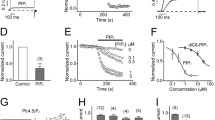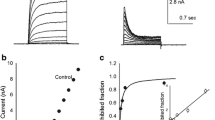Abstract
The depolarisation activated human ether à go-go (hEAG) potassium channels are primarily expressed in neuronal tissue but their appearance in various tumour entities is also indicative of an oncogenic role. Because upregulation of hEAG channels may yield to an enhanced cell proliferation, interventions increasing hEAG1 currents may serve similar purposes. We therefore investigated the effects of polyunsaturated fatty acids on hEAG1 channels. Arachidonic acid (AA) lowered their activation threshold, accelerated the activation kinetics and increased the open probability with a half-maximal concentration of about 4 μM. This effect correlated with the number of double bonds (db) in the fatty acids, increasing from oleic acid (1 db), linolenic acid (3 db), AA (4 db) to eicosapentaenoic acid (5 db). Unlike other voltage-gated K+ channels, hEAG1 channels are not blocked by arachidonic acid. Therefore, in particular at typical resting potentials of tumour cells (−30 mV), AA potently activated hEAG1 channels in a reversible manner. Proliferation and metabolic activity of hEAG1-expressing human melanoma cells increased when cells were exposed to AA concentrations of 5 μM and this effect was suppressed in the presence of the hEAG1 blocker LY97241 suggesting that the proliferative effect of AA is in part mediated by activation of hEAG channels.








Similar content being viewed by others
References
Bauer CK, Schwarz JR (2001) Physiology of EAG K+ channels. J Membr Biol 182:1–15
Broughton SJ, Kitamoto T, Greenspan RJ (2004) Excitatory and inhibitory switches for courtship in the brain of Drosophila melanogaster. Curr Biol 14:538–547
Camacho J (2006) Ether à go-go potassium channels and cancer. Cancer Lett 233:1–9
Capdevila J, Gil L, Orellana M, Marnett LJ, Mason JI, Yadagiri P, Falck JR (1988) Inhibitors of cytochrome P-450-dependent arachidonic acid metabolism. Arch Biochem Biophys 261:257–263
Colbert CM, Pan E (1999) Arachidonic acid reciprocally alters the availability of transient and sustained dendritic K+ channels in hippocampal CA1 pyramidal neurons. J Neurosci 19:8163–8171
Denkins Y, Kempf D, Ferniz M, Nileshwar S, Marchetti D (2005) Role of omega-3 polyunsaturated fatty acids on cyclooxygenase-2 metabolism in brain-metastatic melanoma. J Lipid Res 46:1278–1284
Denson DD, Wang X, Worrell RT, Eaton DC (2000) Effects of fatty acids on BK channels in GH3 cells. Am J Physiol Cell Physiol 279:C1211–C1219
Farias LM, Ocana DB, Diaz L, Larrea F, Avila-Chavez E, Cadena A, Hinojosa LM, Lara G, Villanueva LA, Vargas C, Hernandez-Gallegos E, Camacho-Arrayo I, Duenas-Gonzalez A, Perez-Cardenas E, Pardo LA, Morales A, Taja-Chayeb L, Escamilla J, Sanchez-Pena C, Camacho J (2004) Ether à go-go potassium channels as human cervical cancer markers. Cancer Res 64:6996–7001
Gavrilova-Ruch O, Schönherr K, Gessner G, Schönherr R, Klapperstück T, Wohlrab W, Heinemann SH (2002) Effects of imipramine on ion channels and proliferation of IGR1 melanoma cells. J Membr Biol 188:137–149
Gessner G, Heinemann SH (2003) Inhibition of hEAG1 and hERG1 potassium channels by clofilium and its tertiary analog LY97241. Br J Pharmacol 138:161–171
Guizy M, Arias C, David M, González T, Valenzuela C (2005) Ω-3 and Ω-6 polyunsaturated fatty acids block HERG channels. Am J Physiol Cell Physiol 289:C1251–C1260
Hamilton KL, Syme CA, Devor DC (2003) Molecular localisation of the inhibitory arachidonic acid binding site to the pore of hIK1. J Biol Chem 278:16690–16697
Hegle AP, Marble DD, Wilson GF (2006) A voltage-driven switch for ion-independent signaling by ether-a-go-go K+ channels. Proc Natl Acad Sci USA 103:2886–2891
Honoré E, Barchanin J, Attali B, Lesage F, Lazdunski M (1994) External blockade of the major cardiac delayed-rectifier K* channel (Kv1.5) by polyunsaturated fatty acids. Proc Natl Acad Sci USA 91:1937–1944
Ju M, Wray D (2002) Molecular identification and characterisation of the human eag 2 potassium channel. FEBS Lett 524:204–210
Kim Y, Gnatenco C, Bang H, Kim D (2001) Localization of TREK-2 K+ channel domains that regulate channel kinetics and sensitivity to pressure, fatty acids and pHi. Pflügers Arch 442:952–960
Kogteva GS, Bezuglov VV (1998) Unsaturated fatty acids as endogenous bioregulators. Biochemistry (Moscow) 63:4–12
Lauritzen I, Blondeau N, Heurteaux C, Widmann C, Romey G, Lazdunski M (2000) Polyunsaturated fatty acids are potent neuroprotectors. EMBO J 19:1784–1793
Liu Y, Liu D, Heath L, Meyers DM, Krafte DS, Wagoner PK, Silvia CP, Yu W, Curran ME (2001) Direct activation of an inwardly rectifying potassium channel by arachidonic acid. Mol Pharmacol 59:1061–1068
Macica CM, Yang Y, Lerea K, Hebert SC, Wang W (1998) Role of the NH2 terminus of the cloned renal K+ channel, ROMK1, in arachidonic acid-mediated inhibition. Am J Physiol 274:F175–F181
Nie D, Honn KV (2004) Eicosanoid regulation of angiogenesis in tumors. Semin Thromb Hemost 30:119–125
Occhiodoro T, Bernheim L, Liu JH, Bijlenga P, Sinnreich M, Bader CR, Fischer-Lougheed J (1998) Cloning of a human ether-a-go-go potassium channel expressed in myoblasts at the onset of fusion. FEBS Lett 434:177–182
Oliver D, Lien C-C, Soom M, Baukrowitz T, Jonas P, Fakler B (2004) Functional conversion between A-type and delayed rectifier K+ channels by membrane lipids. Science 304:265–270
Pardo LA, del Camino D, Sánchez A, Alves F, Brüggemann A, Beckh S, Stühmer W (1999) Oncogenic potential of EAG K+ channels. EMBO J 18:5540–5547
Pardo LA (2004) Voltage-gated potassium channels in cell proliferation. Physiology 19:285–292
Patel AL, Honoré E, Maingret F, Lesage F, Fink M, Duprat F, Lazdunski M (1998) A mammalian two pore domain mechano-gated S-like K+ channel. EMBO J 15:4283–4290
Piomelli D (1996) Arachidonic acid in cell signalling. Springer, Berlin Heidelberg New York, 195 pp
Rogalski SL, Chavkin C (2001) Eicosanoids inhibit the G-protein-gated inwardly rectifying potassium channel (Kir 3) at the Na+/PIP2 gating site. J Biol Chem 276:14855–14860
Saganich MJ, Machado E, Rudy B (2001) Differential expression of genes encoding subthreshold-operating voltage-gated K+ channels in brain. J Neurosci 21:4609–4624
Sanguinetti MC, Tristani-Firouzi M (2006) hERG potassium channels and cardiac arrhythmia. Nature 440:463–469
Schledermann W, Wulfsen I, Schwarz JR, Bauer CK (2001) Modulation of rat erg1, erg2, erg3 and HERG K+ currents by thyrotropin-releasing hormone in anterior pituitary cells via the native signal cascade. J Physiol 532:143–163
Schönherr R (2005) Clinical relevance of ion channels for diagnosis and therapy of cancer. J Membr Biol 205:175–184
Schönherr R, Gessner G, Löber K, Heinemann SH (2002) Functional distinction of human EAG1 and EAG2 potassium channels. FEBS Lett 514:204–208
Schönherr R, Löber K, Heinemann SH (2000) Inhibition of human ether a go-go potassium channels by Ca2+/calmodulin. EMBO J 19:3263–3271
Schönherr R, Mannuzzu LM, Isacoff EY, Heinemann SH (2002) Conformational switch between slow and fast gating modes: allosteric regulation of voltage sensor mobility on the EAG K+ channel. Neuron 35:935–949
Silverman WR, Tang CY, Mock AF, Huh KB, Papazian DM (2000) Mg2+ modulates voltage-dependent activation in ether-a-go-go potassium channels by binding between transmembrane segments S2 and S3. J Gen Physiol 116:663–678
Snyders DJ, Tamkun MM, Bennet PB (1993) A rapidly activating and slowly inactivation potassium channel cloned from human heart. Functional analysis after stable mammalian cell culture expression. J Gen Physiol 101:513–543
Stühmer W, Alves F, Hartung F, Zientkowska M, Pardo LA (2006) Potassium channels as tumour markers. FEBS Lett 580:2850–2852
Terlau H, Ludwig J, Steffan R, Pongs O, Stühmer W, Heinemann SH (1996) Extracellular Mg2+ regulates activation of rat eag potassium channel. Pflügers Arch 432:301–312
Villarroel A, Schwarz T (1996) Inhibition of the Kv4 (Shal) family of transient K+ currents by arachidonic acid. J Neurosci 16:2522–2531
Wang J, Zhang Y, Wang H, Han H, Nattel S, Yang B, Wang Z (2004) Potential mechanism for the enhancement of HERG K+ channel function by phospholipid metabolites. Br J Pharmacol 141:586–599
Zheng HF, Li XL, Jin ZY, Sun JB, Li ZB, Xu WX (2005) Effects of unsaturated fatty acids on calcium-activated potassium current in gastric myocytes of guinea pigs. World J Gastroenterol 11:672–675
Acknowledgments
This work was supported by the DFG (SFB 604, TP A4). We are grateful for technical assistance by S. Arend and A. Rossner and helpful comments regarding proliferation assays by K. Schönherr.
Author information
Authors and Affiliations
Corresponding author
Rights and permissions
About this article
Cite this article
Gavrilova-Ruch, O., Schönherr, R. & Heinemann, S.H. Activation of hEAG1 potassium channels by arachidonic acid. Pflugers Arch - Eur J Physiol 453, 891–903 (2007). https://doi.org/10.1007/s00424-006-0173-3
Received:
Accepted:
Published:
Issue Date:
DOI: https://doi.org/10.1007/s00424-006-0173-3




